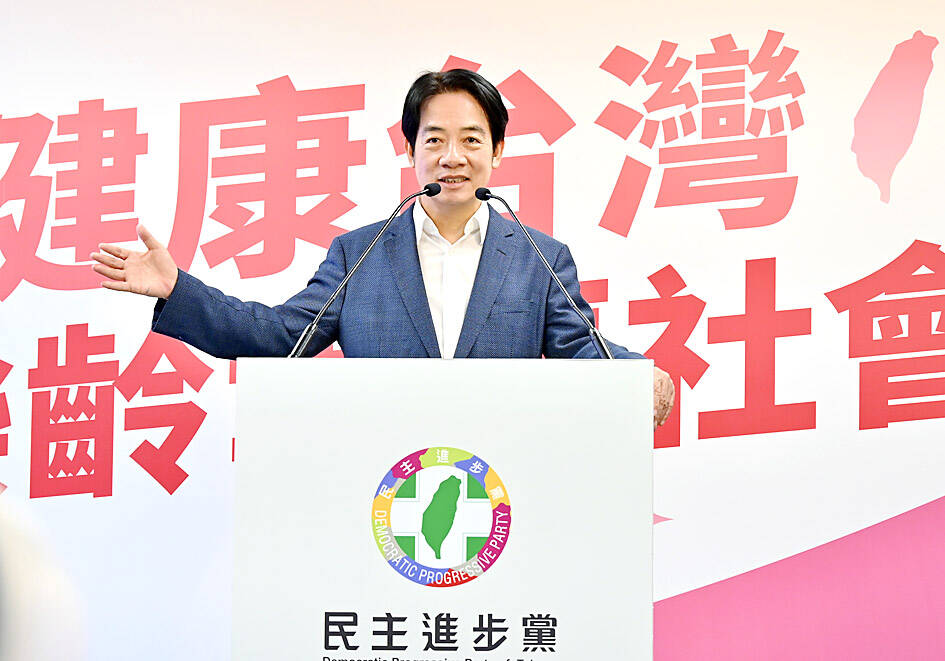President William Lai (賴清德) yesterday announced a goal to reduce mortality rates from illnesses from the “three highs” — high blood pressure, blood sugar and blood cholesterol levels — by 33 percent in five years.
He made the remark at the third meeting of the Healthy Taiwan Promotion Committee, saying that seven out of 10 leading causes of deaths in the nation are linked to the “three highs.”
Treatment for chronic disorders associated with the “three highs” cost the nation about NT$170 billion (US$5.18 billion) every year, which is straining the National Health Insurance’s (NHI) sustainability, he said.

Photo: George Tsorng, Taipei Times
According to the WHO, tobacco use, physical inactivity, unhealthy diet and harmful alcohol use are risk factors contributing to noncommunicable diseases, Lai said.
The latest Nutrition and Health Survey in Taiwan showed that the average Taiwanese had moderate or inadequate exercise, ate an unhealthy diet and engaged in harmful alcohol use, he said.
The survey indicated that diet was a cause for concern, as the average Taiwanese diet consisted of highly imbalanced nutrition, including excessive sugar and salt, and inadequate amounts of fruits, vegetables and milk, Lai said.
The most pressing health issues affecting Taiwanese are best addressed pre-emptively by encouraging the public to eat better and be more physically active, he added.
The Ministry of Health and Welfare also lowered the minimum age to qualify for adult preventive medical care to 30 starting this year, Lai said.
The “888 program,” which would identify people with the “three highs” and give them pre-emptive care, is being prepared, Lai added.
Under the program, the government and the private sector would work together in reducing deaths and function loss due to chronic illnesses at the workplace, in communities, on campuses, and in the civil and military service, he said.
In other news, the ministry has been stockpiling flu vaccines and implementing preventive measures in response to complaints about congested hospitals, Lai said.
Central and local government officials are working together to increase hospitals’ ability to share beds and to enforce the hierarchy of medical services to prevent waste, he said.
The Cabinet has been instructed to continue policies that encourage hospitals to increase medium and long-term care staff, increase capacity for critical care and allow outpatient medical services, Lai said.
The agenda for the previous year’s Healthy Taiwan Promotion Committee meeting of reducing cancer deaths by one-third by 2030 is being implemented, he said, adding that NHI coverage for cancer screening was broadened to include more age groups and cancer types.
More funds were also allocated for cancer-related research, such as genetic screening and targeted therapy, Lai said.

The first two F-16V Bock 70 jets purchased from the US are expected to arrive in Taiwan around Double Ten National Day, which is on Oct. 10, a military source said yesterday. Of the 66 F-16V Block 70 jets purchased from the US, the first completed production in March, the source said, adding that since then three jets have been produced per month. Although there were reports of engine defects, the issue has been resolved, they said. After the jets arrive in Taiwan, they must first pass testing by the air force before they would officially become Taiwan’s property, they said. The air force

GLOBAL: Although Matsu has limited capacity for large numbers of domestic tourists, it would be a great high-end destination for international travelers, an official said Lienchiang County’s (Matsu) unique landscape and Cold War history give it great potential to be marketed as a destination for international travelers, Tourism Administration Director General Chen Yu-hsiu (陳玉秀) said at the weekend. Tourism officials traveled to the outlying island for the Matsu Biennial, an art festival that started on Friday to celebrate Matsu’s culture, history and landscape. Travelers to Matsu, which lies about 190km northwest of Taipei, must fly or take the state-run New Taima passenger ship. However, flights are often canceled during fog season from April to June. Chen spoke about her vision to promote Matsu as a tourist attraction in

The Chinese People’s Liberation Army Navy’s (PLAN) third aircraft carrier, the Fujian, would pose a steep challenge to Taiwan’s ability to defend itself against a full-scale invasion, a defense expert said yesterday. Institute of National Defense and Security Research analyst Chieh Chung (揭仲) made the comment hours after the PLAN confirmed the carrier recently passed through the Taiwan Strait to conduct “scientific research tests and training missions” in the South China Sea. China has two carriers in operation — the Liaoning and the Shandong — with the Fujian undergoing sea trials. Although the PLAN needs time to train the Fujian’s air wing and

PAWSITIVE IMPACT: A shop owner said that while he adopted cats to take care of rodents, they have also attracted younger visitors who also buy his dried goods In Taipei’s Dadaocheng (大稻埕), cats lounging in shops along Dihua Street do more than nap amid the scent of dried seafood. Many have become beloved fixtures who double as photography models, attracting visitors and helping boost sales in one of the capital’s most historic quarters. A recent photo contest featuring more than a dozen shop cats drew more than 2,200 submissions, turning everyday cat-spotting into a friendly competition that attracted amateur and professional photographers. “It’s rare to see cats standing, so when it suddenly did, it felt like a lucky cat,” said Sabrina Hsu (徐淳蔚), who won the NT$10,000 top prize in